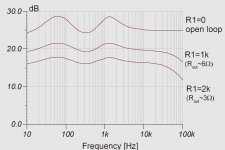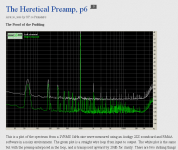Most sensitive analogue designs I lay out these days tend to use 0.1%, so an optimised layout using this sort of tolerance would be better?I think that the original statement of 1dB difference was incorrect, because to compare different IC's you are going to use 1% resistors for the feedback loops and you would use the same values, so you are going to be in the 1-2% region, automatically.
It has little to nothing to do with the series R. Thx-RNMarsh
Measurements.
Jan
Attachments
Still, not "tens of milliohms."
AWG11 is my speaker wire, length of cord 2m, i.e. 4m total. Tens of miliohms. Not many people are as unpleasant as you are.
AWG11 is my speaker wire, length of cord 2m, i.e. 4m total. Tens of miliohms. Not many people are as unpleasant as you are.
Mine is a little thinner, 12. Good enough.
Yours is certainly thicker than "usual," and you have the advantage of a nice, sort run, shorter than most. I wish I could in my room.
Not many people are as unpleasant as you are.
unpleasant or unpleased?
George
This is called 'quibbling' to dismiss a 'claim' even from real engineers, who are usually very skeptical of IC differences.
You don't have to trim 1% resistors to get close to 0.1dB.
Then why did you bring up resistor tolerances in the first place?
Let's run the numbers. If you have 1% resistors, the gain can be off from one setup to another by 2% worst case. It may well be better, but don't count on it until you check for yourself. That's around 0.18dB level difference, which is hard to hear but still well within perception for sharp listeners (who will perceive it as a tiny bit more clarity).
So, minor effect, but a potentially audible confounder and easy to prevent.
ONE in 1000 SY.
I don't follow your statistics, but in any event, it's easy to prevent and control. I match my gain control and EQ resistors and capacitors to 0.1% using some basic equipment- the nice thing is that for most circuits, it's the ratio that counts, not (within reason) the absolute numbers. I'm sure you do the same thing.
OK everybody, just get a batch of 1% resistors, perhaps around 1K-10K, the normal values that would be used. NOW, measure a number of randomly picked samples with a good multimeter, a Fluke or an HP will do. Now note how far they deviate from perfect.
Then calculate the chances that you could RANDOMLY pick two resistors that are almost 1% off in the same direction, in order to get what SY implies.
I guessed at 1 in 1000. It might be 1 in 100, or 1 in 1million. You do the math.
Then calculate the chances that you could RANDOMLY pick two resistors that are almost 1% off in the same direction, in order to get what SY implies.
I guessed at 1 in 1000. It might be 1 in 100, or 1 in 1million. You do the math.
.18db perception ! Sharp listeners ! you can't make this shizzle up, engineered boutique hi-fi ?🙄


What about temperature and humidity, or the resulting effective density of the ether around you? Should you not do you testing at the same ambient conditions since hairs are being split with the electronics? Houston summers versus Minneapolis winters?
I guessed at 1 in 1000. It might be 1 in 100, or 1 in 1million. You do the math.
I'm rather surprised that you weren't aware that this depends on the distribution for one batch to another, one type to another, and one manufacturer to another. So it can't be universally calculated.
Seems a lot easier to spend a minute or two finding some matched pairs. Don't you do that?
What about temperature and humidity, or the resulting effective density of the ether around you?
Affects absolute values, unlikely relative values.
OK everybody, just get a batch of 1% resistors, perhaps around 1K-10K, the normal values that would be used. NOW, measure a number of randomly picked samples with a good multimeter, a Fluke or an HP will do. Now note how far they deviate from perfect.
Then calculate the chances that you could RANDOMLY pick two resistors that are almost 1% off in the same direction, in order to get what SY implies.
I guessed at 1 in 1000. It might be 1 in 100, or 1 in 1million. You do the math.
You should measure and match them vs freq , not DCR , well if you decide to get serious...
🙂
Give me a break, a. Do you NOT think that they will match in frequency response? What I wrong with you? You know, same brand, same part type, 1K-10K, and SAME TOLERANCE?
I don't follow your statistics, but in any event, it's easy to prevent and control. I match my gain control and EQ resistors and capacitors to 0.1% using some basic equipment- the nice thing is that for most circuits, it's the ratio that counts, not (within reason) the absolute numbers. I'm sure you do the same thing.
And I do not follow you. You care about precision of passive components and then you use them in mediocre valve amplifiers and get mediocre measurements like this. You care in passive precision is not helpful here.
Attachments
- Status
- Not open for further replies.
- Home
- Member Areas
- The Lounge
- John Curl's Blowtorch preamplifier part II


